|
 Prehistoric
Cave Art:
Prehistoric
Cave Art: 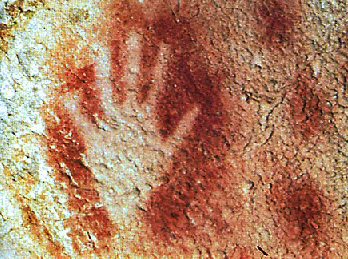
Prehistoric
cave-art is important as it serves as some of the best means of
showing the interaction between our primitive ancestors and the
world as they perceived it.
The Image
(right) is the most basic self portrait (From Pech Merle, c.
25,000 BP). Through it we can see the first steps of our awakenings as
a species.
There are certain
characteristics of cave-art that allow us to begin to form an
impression of the people behind the drawings, often found at the depths of long, deep tunnel systems in
small secretive caverns.
Quick Links:
Article: Nature.com (May, 2013)
'The Earliest Known Cave Paintings Fuel
Arguments About Whether Neanderthals Were The Mental
Equivalent to Modern Humans'.
|
Origins of Cave-art:
'Origins of Consciousness'. |
Until recently,
the
earliest European cave-art dates from Chauvet in France, around
32,000 years ago. (2)
With over 350 cave-art sites in France and Spain
alone, variously occupied over the 25,000 years preceding the
end of the last ice-age, it is surprising to find that the range
of cave-art is so narrow.
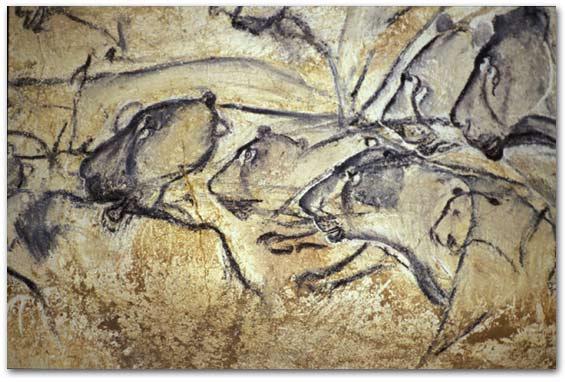
Predatory
Felines. Chauvet, France c. 30,000 BP. Some of the earliest
cave-art in the world.
Article:
ScienceDaily.com: (June, 2012)
Oldest Rock
Art in Europe Discovered In Spain.
'Recent
studies have shown that the 'Palaeolithic
paintings in El Castillo cave in Northern Spain date back at
least 40,800 years' -- making them Europe's oldest known cave
art, according to new research published June 14 in
Science.
Hand stencils and disks made by blowing paint
onto the wall in El Castillo cave were found to
date back to at least 40,800 years, making them
the oldest known cave art in Europe, 5-10,000
years older than previous examples from France.
A large club-shaped symbol in the famous
polychrome chamber at Altamira was found to be
at least 35,600 years old, indicating that
painting started there 10,000 years earlier than
previously thought, and that the cave was
revisited and painted a number of times over a
period spanning more than 20,000 years'.
(8)
(Link
to Full Aritcle)
The first real
claim for the existence of Palaeolithic cave art was that made
in 1880 for the Spanish cave of Altamira by a
local landowner, de Sautuola. His views were treated with
scepticism by the archaeological establishment, because nothing
similar had previously been reported, and almost all known
portable art had come from France. The rejection of Altamira
persisted for twenty years until a breakthrough was made at the
cave of La Mouthe (Dordogne) where, in 1895, the removal of some fill
had exposed an unknown gallery, the walls of which had
engravings including a bison figure. Because of Palaeolithic
deposits in the blocking fill, it was clear that the pictures
must be ancient. Finally, in 1901, engravings were found in
the cave of Les Combarelles (Dordogne) and paintings in the
nearby cave of Font de Gaume. In 1902 the existence of cave art
was officially recognized by the archaeological establishment.
The Distribution
of European Cave-art.
The distribution of cave art (art pari�tal) is
equally patchy, though it is most abundant in areas that are
also rich in decorated objects: the P�rigord, the French
Pyrenees, and Cantabrian Spain. Palaeolithic decorated caves
are found from Portugal and the very south of Spain to the
north of France. Traces have been found in southwest
Germany, and there are concentrations in Italy and Sicily. A
handful of caves are also known in Yugoslavia, Romania, and
Russia. The current total for Eurasia is about 280 sites.
Some contain only one or a few figures on the walls, whereas
others like
Lascaux or Les Trois Fr�res have hundreds.
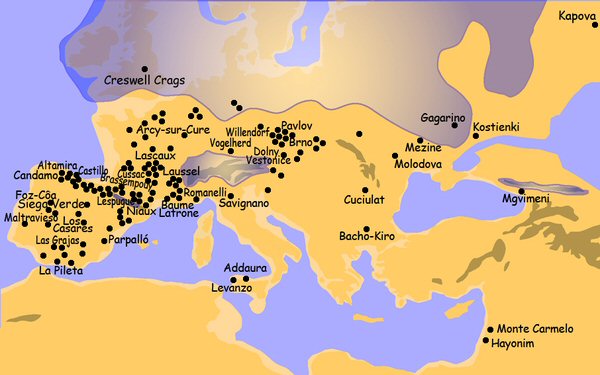
Distribution of primary
Palaeolithic cave-art locations in Eurasia.
In recent years it has become apparent that
Palaeolithic people also produced rock art in the open air,
where it has survived in exceptional circumstances: Six
sites have so far been found in Spain, Portugal, and the
French Pyrenees with engravings that are Palaeolithic in
style. So cave art is not typical of the period; caves are
merely the places where most art has survived.
What Materials did they use?
The range of colours
Palaeolithic man found
in the natural world is quite remarkable �
reds in the form of iron ore, blacks in the
form of charcoal or manganese, yellows from
iron oxide and whites from chalk or even
burned bone or shell. Clay ochre too
provided some basic colours. The artists
displayed incredible ingenuity in applying
these pigments to their pictures. At
Lascaux, for instance, hundreds of
rudimentary pigment crayons were discovered
scattered around the floor. Analysis of some
of these has revealed that artists used
recipes to prepare them, combining the raw
colour with talc or feldspar to increase
their bulk, and adding animal and plant oils
to bind the materials.
(4)
Analysis of
samples of pigment from Lascaux revealed scarce manganese oxide
minerals, including groutite, hausmannite, and manganite.
Because there are no known deposits of these minerals in the
area, more distant origins and trade-routes are inferred. The
nearest modern known Mn-rich province from Lascaux is the
Pyrenees, which is 250 km from the Dordoigne area.
(7)
The early dates attributed to
these very specific oxides, and their common use in adornment
and covering the dead in funerary rituals worldwide make it a
reasonable speculation that the origins of mining are linked in
with the need for pigment.
(More
about Mining in Prehistory)
|
The Mystery of La Marche.
(15,000 B.P.)
Hundreds of beautifully engraved and painted human
heads and faces were discovered on slates carefully
placed so as to cover the floor of the cave at La
Marche. Just to make the discovery even more unique,
several of the sketches include representations of
clothing.
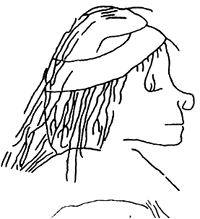 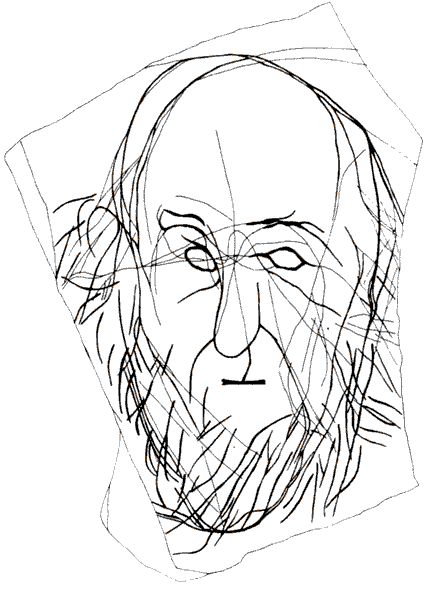 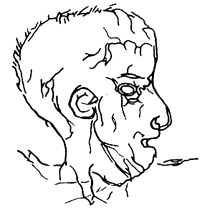 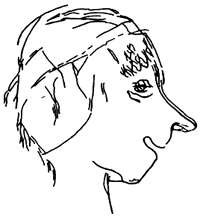
Some of the human
heads and faces discovered on slates on the floor at
La Marche, France.
|
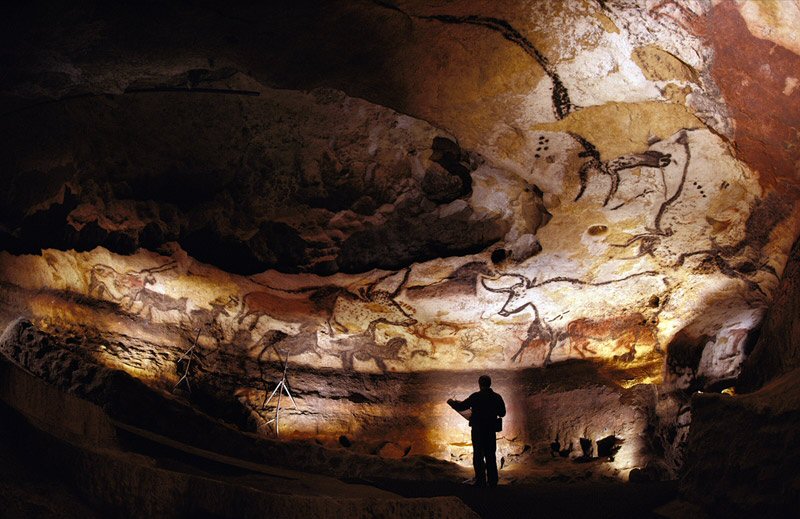
Lascaux Cave. These drawings are over 17,000 years
old. They are suggested to have astronomical relevance.
At Lascaux, sockets in the walls
show that a
scaffold system was used for painting the ceiling drawings.
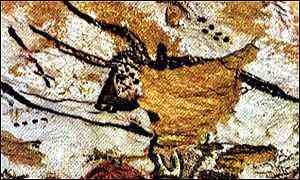
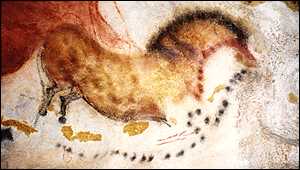
Lascaux, France. (Left) Pleiades and Taurus, (Right)
Suggested Lunar
Count (3).
Article:
Lascaux Under Threat.
'The cave has been under attack since 1998 from
mould, fungi and bacteria. A new air conditioning system put into
place in 2000 involved many workers coming in and out of the cave
and it is believed that they did not properly disinfect their shoes
upon entering, thereby bringing a common local mould into the cave.
Authorities began spraying massive doses of antibiotics and
fungicides in an effort to stop the rapidly spreading organisms. The
foreign organisms continued to advance so most of the air
conditioning system was shut down raising the temperature of the
cave.
In 2001, authorities aggressively poured
quicklime over the floor of the cave in an effort to stop the
fungus. Compresses soaked in a mixture of fungicides and antibiotics
were then applied directly on the paintings.
By 2002, the fungi and mould retreated, but the
bacteria were still causing large dark spots to grow in the cave. An
invasive and highly labour intensive, mechanical removal treatment
was then tried. This involved the removal of the bacteria's roots
and proved to be damaging because crews were constantly inside
physically removing the spots. Furthermore, the brown bacterial
spots that remain are highly visible.
By 2006, colonies of black spots, some as large
as human hands, were quickly proliferating, spreading over painted
and unpainted surfaces. The spots have yet to be identified by a
microbiologist. Some of the paintings are in critical condition and
colour tones are fading.
The cave, in addition, is currently very wet and
water can be seen running over the face of paintings. The limestone
which gave the cave a remarkable brilliance, has turned grey.
Current managers have found no treatment and the spots continue to
spread'.
(More
about the Lascaux Caves)
|
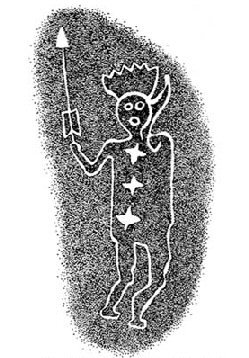
Pleiades and the Taurus Constellation.
Research into the prominence of clusters of
seven dots alongside images of Auroch's in European
cave-art has led to the suggestion that they may represent the
first indications of constellations. (5)
The heliacal rising of Pleiades was one of
the most important celestial markers after the moon to
prehistoric people around the world. It represented the
beginning of the new-year and of the agricultural season.
Markings on bones, stones and paintings on cave walls have shown
that the sky was probably used for orientating in time and
space.
As well as Lascaux, a panel in the cave of
La-Tete-du-Lion, France c 21,000 BP) also has a combination of
Auroch (Bull-Aldebaran) and seven dots (Pleiades). In addition,
at both sites, the eye of the bovine marks the position of
Aldebaran, the primary star in the Taurus constellation.
(More
about Palaeolithic Astronomy)
A
survey of cave-symbols has highlighted the appearance of 26
symbols which appear to repeat themselves around the
Palaeolithic world.
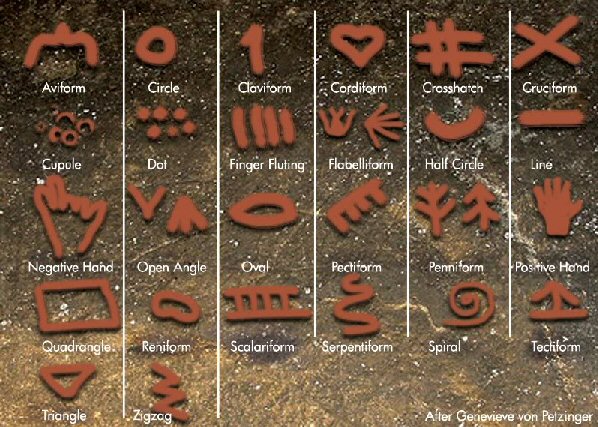
A Chart of
the 26 reccurring shapes (proto-alphabet) from the 146
French rock art
sites.
(More
about Palaeolithic Writing)
|
Shamanic Cave-art:
'The Evolution
of Imagination'. |
This interpretation
of Palaeolithic cave-art reflects the suggestion of an interest
in the metaphysical side of life. Images of mixtures of humans and
animals are proposed to be 'visionary' and suggestive of profound experiences, often suggested to have
been drug-induced.
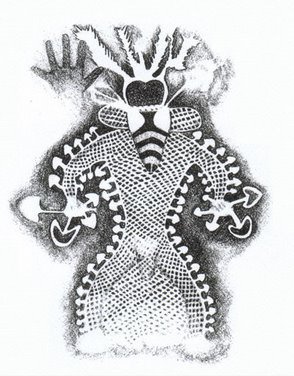
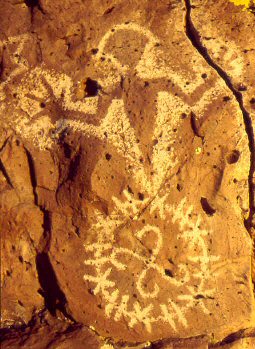
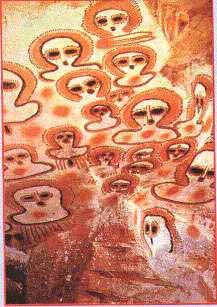
Left: Mushroom/Bee
Man. Centre: Moab Shaman. Right: Australian Petroglyphs.
(More
about Drug-Use in Prehistory)
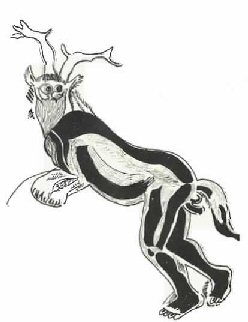
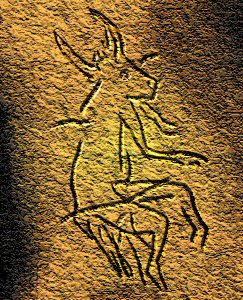
Left: The
'Sorcerer', from Trois Freres, France. Right: Similar figure, Dordoigne.
These hybrid figures
are considered as evidence of early shamanic practices from the
Palaeolithic era.
(More
about Shamanism)
There is apparently
little cave-art concerned with reproduction or fertility in cave-art. However on
occasion on can find painted on the walls of caves in Europe,
illustrations of the Palaeolithic sexuality as seen through the
following images:
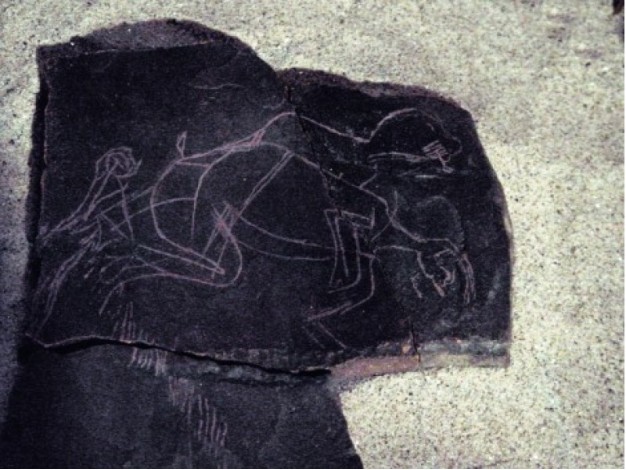
La
Marche, France. One of several 'erotic' drawings discovered
there.
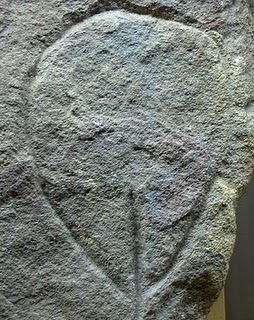
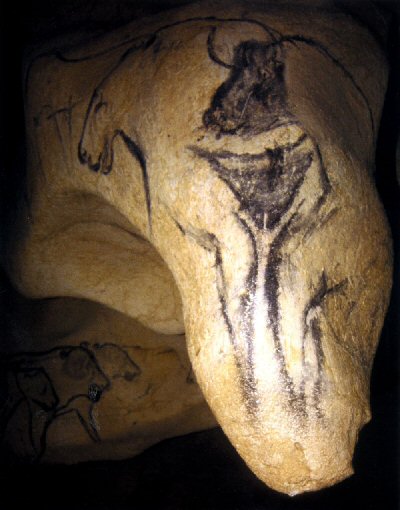
These examples of Palaeolithic
'vulva' art are only a couple of several found associated
with European cave-art. The image on the right is from Chauvet cave
in France. It has a feline on one side, and a bull on the other. The
two animals combine to create the image of a female vulva..
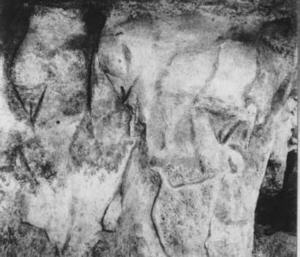
These three women
are called the 'Angles sur l'Anglin', France.
(Iakovleva,
Pin�on 1997, fig. 162-169).
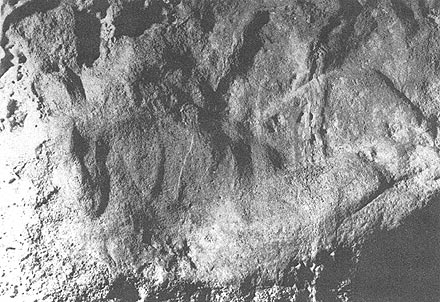
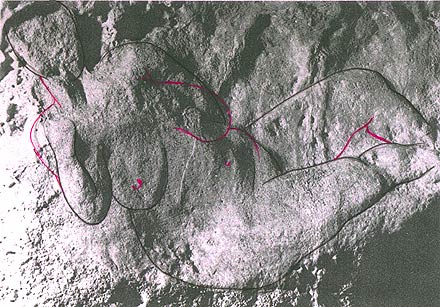
Reclining female
nude, cave wall engraving, The Dordogne, France, c. 12,000 B.C.
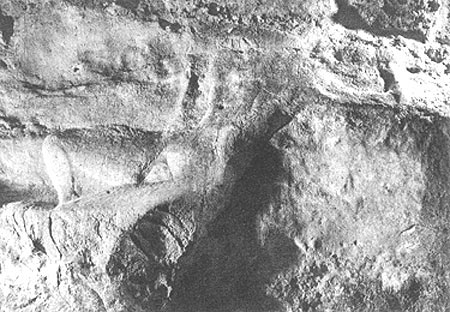
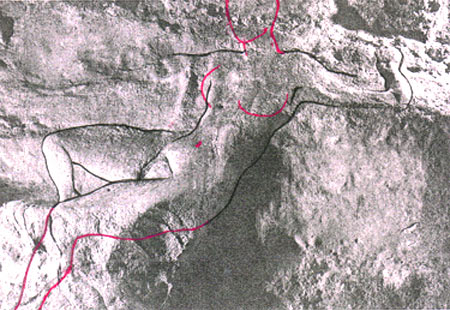
Reclining female
nude, cave wall engraving, La Magdelaine Cave, France, c.
15,000-10,000 B.C.
(Hohle
Fels Phallus and Venus Figurine, Germany)
The study of Palaeo-acoustics has revealed that
several ancient structures were built so as to incorporate acoustic
phenomena in their design. Examples such as the
Hypogeum in Malta, and the Mayan
Temples at Chitzen Itza
demonstrate that this science was well recognised and understood in
Neolithic times but remarkably, this same effect was already being initiated at several
cave systems in Palaeolithic Europe as the following articles
demonstrate:
Article:
(New Scientist, p. 14, November 28, 1992) - 'The Acoustics Of
Rock Art'
'"..S. Waller has visited rock art sites in Europe,
North America, and Australia. Standing well back from the painted
walls, he claps or creates percussion sounds, and records the echo's
bouncing back. It turns out, that rock art seems to be placed
intentionally where echo's are not only unusually loud but are also
related to the pictured subject matter. Where hoofed animals are
depicted, one easily evokes echo's of a running herd. If a person is
drawn, the echo's of voices seem to emanate from the picture itself!
"At open air sites
with paintings, Waller found that echo's reverberate on average at a
level 8 decibels above the level of the background. At sites without
art the average was 3 decibels. In deep caves such as Lascaux and
Font-de-Gaume in France, echo's in painted chambers produce sound
levels of between 23 and 31 decibels. Deep cave walls painted with
cats produce sounds from about 1 to 7 decibels. In contrast, surfaces
without paint are 'totally flat'."
(More About Prehistoric Acoustic
Phenomena)
|
Three-dimensional Palaeolithic Art: |
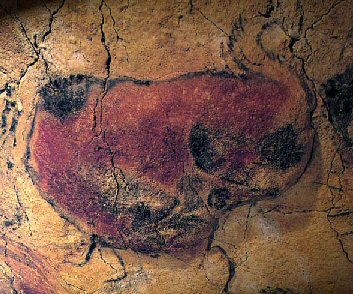
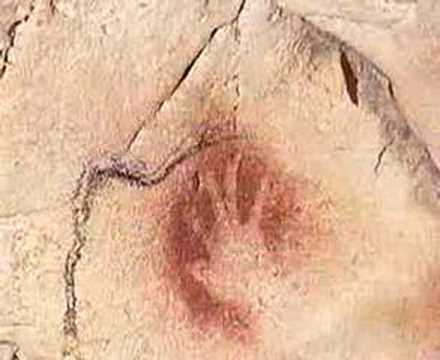
Left: One of
several 3-dimensional Buffalo at
Altamira, Spain, and Right: Hand and horse at
Chauvet in France.

Note the use of
the rock outcrop at Peche Merle, France.

Only 18 sites of
sculptures are known in France
(6). At Montespan
in France (c. 20,000 BP), a three-dimensional bear was formed out of a whopping 700 kg of the stuff.
Sometimes the natural contours and features of a cave, rock or wall
� stalagmites or other mineral formations � would be used to
accentuate and augment images (most often animals� genitals).

Carvings of
Horses and Bison. L'Abri-du-Cap-Blanc, France. 15,000 BP.
(Chauvet:
The origin of Cave-art)
(Lascaux,
France)
(La
Marche, France)
(Shamanism) (Archaeoastronomy) (Venus
Figurines)
(Palaeolithic
Homepage)
|





























